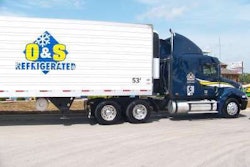House bill would mandate standards by 2011
The House Energy and Commerce Committee approved clean energy legislation (H.R. 2454) that would mandate regulation of greenhouse gas emissions such as carbon dioxide (CO2) from heavy-duty trucks. Under an amendment adopted during the committee’s consideration of the bill on May 21, H.R. 2454 would require the U.S. Environmental Protection Agency to adopt greenhouse gas emissions standards by the end of 2010.
The measure also would overturn legislation adopted by Congress in late 2007 that requires the U.S. Department of Transportation to establish fuel economy standards for work trucks and commercial medium- and heavy-duty trucks following a National Academy of Sciences study; the NAS committee conducting it plans to deliver its report by March of next year.
Although greenhouse gases and fuel economy are related, a regulation focused on lowering CO2 necessarily won’t lead to the same fuel economy improvements as one focused directly on mpg.
For example, EPA and DOT announced last month that they jointly intend to propose regulations establishing vehicle greenhouse gas emissions and fuel economy standards for passenger cars, light-duty trucks and medium-duty passenger vehicles built in model years 2012 through 2016. In the notice, EPA and DOT pointed out that some of the CO2 reduction in the vehicles will come from air conditioning changes that will produce no fuel economy benefits.
Judge blocks key parts of port concessions
Responding to a federal appeals court ruling strongly supporting the trucking industry, U.S. District Judge Christina Snyder issued a ruling in late April enjoining several key provisions of the concession plans imposed by the ports of Long Beach and Los Angeles. Even so, the American Trucking Associations is appealing the district court’s acceptance of a broad motor vehicle safety exception and certain other aspects.
On March 20, the U.S. Court of Appeals for the Ninth Circuit sent ATA’s challenge back to the district court for reconsideration, citing numerous problems with the ports’ concession agreements (see Journal, CCJ, April 2009). In response, Judge Snyder blocked various elements of the concessions, including:
·The employee mandate of the Los Angeles plan that banned owner-operators from the port;
·The driver hiring preferences of both plans;
·The motor carrier financial capability requirements of both plans;
·The driver health insurance mandate of the Long Beach plan;
·The designated routes and parking restrictions of both plans;
·The contractual tie-in of the clean truck tariffs mandated by both plans; and
·The concession fees of both plans.
Volvo backs bigger truck combos
The United States faces a huge gap in the coming years between the amount of freight that needs to be hauled and the amount that can be hauled given current constraints, and longer combination vehicles could help meet the challenge, a top executive of Volvo Trucks North America said last month.
“The challenge is to safely deliver more freight, more efficiently in support of current and future demands,” said Scott Kress, the truck maker’s senior vice president of sales and marketing. Speaking in Boston at a seminar on climate change policy hosted by Volvo Group North America, Kress said that the trucking industry currently estimates the total amount of freight tonnage in the United States will increase 26 percent between 2006 and 2020, requiring a similar increase in the truck population in order to meet the challenge.
But a big increase in the number of trucks will burn more fuel, increase carbon-dioxide emissions, exacerbate congestion and increase accident risk exposure, Kress said, saying the time is right to rethink the current approach. Kress argued that LCVs could reduce congestion, emissions, fuel consumption, transportation costs and dependence on foreign energy. While infrastructure improvements would be needed, they likely would be marginal compared to those that would be needed to support the current approach in the decades to come, he said. And contrary to the claims of trucking’s critics, larger trucks likely would increase safety due to the lower accident risk exposure from fewer trucks, Kress said.
Also speaking at the environmental seminar, American Trucking Associations President Bill Graves noted that allowing more productive trucks was a key element to the sustainability proposal the industry is promoting to Congress. While some industry critics view the idea of bigger trucks as radical, Graves pointed out that a large number of states – including most of the West – already allow trucks to haul 97,000 pounds or more in certain situations.
Meanwhile, the roadblocks to expanding infrastructure are enormous since the Highway Trust Fund practically is broke and neither Democrats nor Republicans are willing to consider increasing fuel taxes despite the trucking industry’s willingness to pay them for highway capacity, Graves said.
UMTRI finds benefits from bigger trucks
Increases in truck weight and length would have a direct beneficial effect on the challenges facing American businesses, according to a study conducted by the University of Michigan Transportation Research Institute that was commissioned by the National Private Truck Council.
Specifically, the study’s findings implied that significant improvements could be achieved in fuel consumption, cost, congestion, improved distribution efficiency and driver availability by increasing the gross vehicle weight (GVW) up to 97,000 pounds on a six-axle tractor-semitrailer from its current 80,000-pound maximum while at the same time boosting cubic capacity through the use of longer combination vehicles.
“For more than a decade, NPTC has supported modification of federal truck size and weight restrictions in a manner that will improve shipper and carrier productivity,” says Gary Petty, NPTC president and chief executive officer. “While there has been ample anecdotal evidence in the private fleet community that larger trucks would mean greater productivity for the businesses operating them, there has not been, until now, a study that helps support the case for changes in the law based on an independent research analysis of a sample group of companies.”
The final report, “Analysis of the Potential Benefits of Larger Trucks for U.S. Businesses Operating Private Fleets,” estimates a reduction in truck loads of 10 percent if the allowable weight was increased and 6 percent if LCVs were permitted; if both strategies were implemented, then the estimated reduction in truck loads from the members surveyed would be 16 percent.
TA unveils bulk DEF dispensing unit
TravelCenters of America (TA) last month unveiled at its Ann Arbor, Mich., location what it said is likely the first bulk diesel exhaust fluid (DEF) dispensing unit. DEF will be needed as part of the selective catalytic reduction emissions systems that will be used on most heavy-duty diesel engines beginning next year. Originally planned for the second half of 2009, the bulk DEF dispensing unit is housed in TA’s heavy truck repair facility on the Ann Arbor site and is equipped with a weights and measures certified metering device provided by Colonial Chemical Co. of Tabernacle, N.J. TA said that locating the DEF additive indoors at heavy truck repair facilities allows it to resolve any potential issues with product freezing.
TravelCenters also announced that prepackaged 2.5 gallon containers have arrived at its distribution warehouse in LaVergne, Tenn., which will begin supplying TA and Petro Stopping Centers locations immediately. All of TA’s 234 locations and all of TA’s 400-plus Road Squad emergency roadside assistance vehicles were expected to have supply available by early June, the company says.
In Brief
Freight Transportation Services Index fell 3.3 percent in March from its February level, falling to its lowest level in more than six years, the U.S. Department of Transportation’s Bureau of Transportation Statistics reported. The March decrease was the largest monthly drop for any month since March 2000. The index fell 6.4 percent from March 2008 to March 2009.
Mack Trucks and the United Auto Workers reached a tentative agreement on terms of a new 40-month Master Agreement that would cover about 1,700 UAW members at seven facilities in three states.
The Great American Trucking Show will host the 2010 Engine Super Sessions and Ride and Drive on Aug. 20 in Dallas. The sessions will explore the technological and operational aspects of engines meeting the next round of emissions reductions. For more information, go to www.gatsonline.com.
Virginia Department of Transportation modified its original plan to close 25 of the state’s 41 interstate highway rest areas as part of a cost-cutting plan to address a budget shortfall. In response to concerns about truck parking, VDOT decided to scale back the closures to 19 and to add 225 truck parking spaces at the remaining locations.
Kenworth Truck Co. and Stonyfield Farm were among the 15 recipients of the Environmental Protection Agency’s ninth annual Clean Air Excellence Awards. EPA recognized Kenworth for its efforts in no-idle, hybrid and natural gas technologies, while Stonyfield Farm was praised for its efforts to reduce greenhouse gas emissions through more efficient vehicles and distribution policies.













